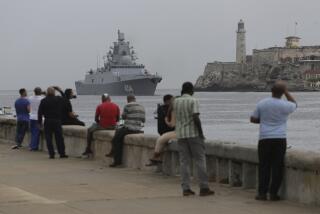U.S. Moved to Head Off Cuban Interference in Grenada Assault
- Share via
WASHINGTON — The United States took special steps to ensure that Cuba would not interfere with the 1983 invasion of Grenada, including the deployment of combat aircraft to Puerto Rico, a newly released Pentagon report discloses.
The report also says U.S. forces did not do enough to suppress enemy anti-aircraft fire and thus protect their helicopters, in part out of a concern for civilian casualties. And it adds that the Pentagon had problems coordinating the role of the Caribbean Peacekeeping Force drawn from other island neighbors of Grenada and that night-time medical evacuation missions were hampered because Army helicopter pilots had not been trained to land on ships.
The report says the planning for the invasion was conducted over such a short period of time that U.S. forces suffered from coordination and communication problems but adds that the invasion was still “accomplished in a most successful manner.”
Those and other observations are contained in a special “Lessons Learned” analysis prepared by Adm. Wesley L. McDonald, the commander in chief of the Atlantic Command. McDonald’s report was actually submitted to the chairman of the Joint Chiefs of Staff in February, 1984, but the report was not cleared for public release--in heavily censored form--until last week. A copy was obtained by a reporter Monday.
To date, no response to McDonald’s recommendations by the joint chiefs has been made public.
Despite the censorship, McDonald’s report provides a fairly detailed look at the chronology of the Grenada invasion and some of the problems that U.S. forces encountered.
Heading Off Interference
It discloses that the Pentagon moved two days before the invasion to make sure that Cuba could not interfere with the mission. While details are not provided, the report says a special “tactical force command” was established by the Air Force at Roosevelt Roads, Puerto Rico, on Oct. 23, 1983.
“Tactical Air Command F-15 and AWACS (airborne warning and control system) aircraft were positioned to provide surveillance and defense against possible interference by Cuban forces . . . (and) to detect and deter any Cuban aircraft flights transiting from Cuba to Grenada,” the report says.
McDonald’s synopsis, entitled “Operation Urgent Fury Report,” said the initial planning of what would become a full-blown invasion began as something much smaller on Oct. 14, 1983, one day after Grenada Prime Minister Maurice Bishop was overthrown and placed under house arrest. On Oct. 14, the report says, McDonald received a “what if” phone call from the Joint Chiefs of Staff “requesting possible options for show-of-force-presence operations in the vicinity of Grenada and possible noncombatant evacuation operations.”
On Oct. 20, the day after Bishop was killed, McDonald received a “warning order for noncombatant evacuation operations” that prompted him to divert the aircraft carrier Independence and a Marine Corps amphibious group, which were on their way to the Mediterranean, toward Grenada.
By Oct. 22, the report adds, the Pentagon was no longer discussing a show-of-force mission but rather had begun planning an invasion under the code name Urgent Fury. Later that day, the joint chiefs “issued an Execute Order for Operation Urgent Fury.”
On Oct. 23, McDonald said, he presented “the concept of operations” to the joint chiefs and “received approval.” The invasion then began early on the morning of Oct. 25, 1983.
More to Read
Sign up for Essential California
The most important California stories and recommendations in your inbox every morning.
You may occasionally receive promotional content from the Los Angeles Times.










